 Image search results - "cruise" Image search results - "cruise" |

On June 16, 2007, Imazu marked the 90th anniversary of the song by organizing a boat cruise on Lake Biwa and other events. Omi-Imazu Station had a sign directing guests to Imazu Port. 90周年の記念「琵琶湖周航クルーズ」の近江今津駅内
|
|

Imazu Port. A large crowd of people waiting to board the chartered boat for a 3-hour cruise on Lake Biwa to commemorate the 90th anniversary of the song, Biwako Shuko no Uta.
|
|

The "Rio Grande" cruise boat awaits at Imazu Port on a miraculously sunny day during the rainy season. 梅雨でありながら、奇跡的にこんないい天気になった。今津港
|
|

Reception desk for passengers. A little over 100 people joined the cruise. クルーズの受付
|
|

Boarding time at Imazu Port. In the forefront is a song monument for Biwako Shuko no Uta.
|
|

Megan and Jamie Thompson about to board the boat. トンプソン姉妹
|
|

Boat name "Rio Grande" operated by Biwako Kisen. Named after Shiga's sister state in Brazil. There is also the "Michigan" paddlewheel boat named after Shiga's sister state in the USA.
|
|

Inside the front of the Rio Grande boat. 琵琶湖周航クルージング
|
|

Open deck at the rear. The boat departed at about 11:30 am.
|
|

We passed by various scenic spots such as Shirahige Shrine, noted for the torii gate in the lake.
|
|

Shirahige Shrine 白髭神社
|
|

Misty Horikiri Port in Omi-Hachiman. Boats leave here for Okishima island, Lake Biwa's largest island.
|
|
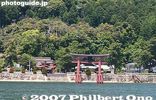
Shirahige Shrine torii as seen from the cruise boat.
|
|

Omi-Maiko with green pines on white sands. 近江舞子の「松は緑に 砂白き」
|
|

Boat for Okinoshima at Horikiri Port
|
|

Omi-Maiko appears in the song.
|
|

Rolling with the waves
|
|
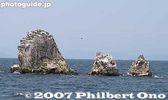
Okino-shiraishi Rocks, a favorite resting place for birds which turned the rocks white from bird droppings. Four rocks stand 80 meters deep in the lake. Out of the water, the tallest stands 14 meters high. 沖の白石
|
|

So what does "Coral shrine" mean in the song? (There's no coral in the lake.) "I think it just refers to a beautiful place..." 「珊瑚の宮」はどういう意味?
|
|

We landed on Chikubushima for about an hour. Jamie and Megan also sang in English in front of the Verse 4 song monument.
|
|

Jamie and Megan Thompson sing in English in front of the Verse 4 song monument, Chikubushima. Next time we need to have an amplifier.
|
|

Jamie and Megan Thompson sing in English in front of the Verse 4 song monument, Chikubushima. They sang up to Verse 4. ジェイミーとメゲン・トンプソン姉妹が歌う
|
|

The man holds the 90th Anniversary tour sign as a guide for the tour guests.
|
|

Getting back on the boat. Little over a hundred people came on this cruise. If people knew it was gonna be such a beautiful day during this rainy season, more would have certainly come.
|
|

Entering Okinoshima Port. Okishima is the largest island in Lake Biwa. MAP
|
|

Sachiko Tsuji, the MC, interviews the sisters before they sang on the boat. 自動販売機前でインタービュー。船内の客は姉妹の顔や姿がほとんど見えへん。
|
|

Jamie and Megan Thompson sing in English while cruising on Lake Biwa. 船の真ん中で歌って自動販売機がバックになって最悪。客に背中を向くばかりで申し訳ない。船の一番前に歌いたいと頼んだけど...
|
|

Side of boat
|
|

After they sang, there was a mad rush to buy the CD priced at 800 yen. 英語版CDの購入者が殺到。
|
|

Then they signed autographs on the CD. CDのサインを求める。
|
|

More autographs. 姉妹はやはり人気者。
|
|

Okishima Port
|
|
|
|

Water lilies. The melody of the song originally came from a song called "Hitsuji-gusa" which means water lilies.
|
|

Water lily (Hitsuji-gusa). ひつじぐさ
|
|

After the boat cruise, there was a walking tour of Imazu. A special exhibition was held at the local community center in Imazu. 「周航の物語展」今津東コミセン
|
|

「周航の物語展」今津東コミセン
|
|

This showcase showed things from the old Daisan Koto Gakko college.
|
|

Student uniform for Daisan Koto Gakko school.
|
|

Daisan Koto Gakko Rowing club towel
|
|

Daisan Koto Gakko book of songs
|
|

Chojiya ryokan along the lake shore. Likely this is where Oguchi Taro and crew stayed. 丁子屋という旅館
|
|

Inside Chojiya. Very impressive Japanese-style inn with lake views.
|
|

Room in Chojiya ryokan.
|
|

Inside Chojiya. The inn is famous for serving duck.
|
|

Another local landmark was this former bank building designed by William Merrell Vories who designed many buildings in Shiga, especially in Omi-Hachiman.
|
|

Leaving Okinoshima (we'll be back).
|
|

Inside former bank building.
|
|

In the evening during 5 pm-6:30pm, a slide show lecture about Oguchi Taro and Yoshida Chiaki was given by Iida Tadayoshi, a song researcher. Held at a hotel in Imazu. 歌と映像でつづる「小口太郎と吉田千秋の物語」講演会
|
|

German-made accordian used by Yoshida Chiaki was also on display.
|
|

View of Imazu shore from hotel
|
|

A reception was held afterward in the hotel. The mayor of Takashima, Hidekazu Kaito, speaks. I gave him a copy of our CD. 高島市長 海東英和
|
|

Interestingly, the mayor's first name "Hidekazu" means "English-Japanese." The next day, at the choir contest, he told us that he listened to and liked our song.
|
|

Kanpai!
|
|

Meeting Iida Tadayoshi, song researcher and former NHK announcer.
|
|

In the end, we all sang the song, including the mayor of Takashima.
|
|

最後に皆で周航歌を歌う。
|
|
|

Setagawa River boat cruise modeled after the Ichiban-Maru paddlewheel steamboat which cruised on Lake Biwa in the 19th century. In operation during warmer months from Ishiyama-dera port and stopping at Nango Aqua Biwa and Seta-no-karahashi ports.
|
|
|

My ticket is for Nagahama to Imazu with a stop on Chikubushima. ¥2,880
|
|
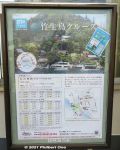
Boat schedule for winter.
|
|
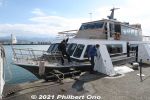
Boat named "Benten" going to Chikubushima.
|
|
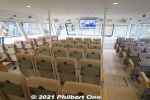
Inside the boat. Very comfortable and well heated in winter.
|
|
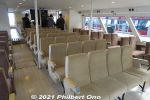
You can sit anywhere you want. Inside Benten. Very comfortable and warm in winter. Not many passengers. Easy to social distance.
|
|
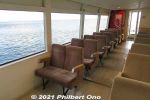
Large picture windows.
|
|
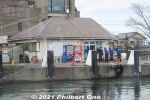
Port staff waving goodbye.
|
|
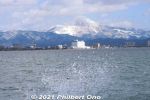
Leaving Nagahama in winter. After a major snowfall in late Jan. 2021, went on a scenic snow cruise on Lake Biwa.
|
|
|
|
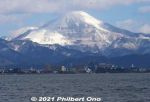
Snowy Mt. Ibuki as seen from Lake Biwa. Shiga Prefecture's highest mountain.
|
|
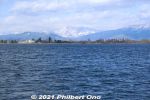
Snowy mountains around Lake Biwa.
|
|

Snowy mountains around Lake Biwa.
|
|

Snowy mountains all around. Mt. Ibuki can be seen on the right. It was a smooth ride.
|
|

Snowy Mt. Ibuki as seen from Lake Biwa. Shiga's highest mountain at 1,377 meters.
|
|
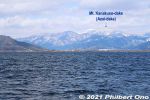
Mt. Kanakuso-dake (金糞岳 or Azai-dake) overlooks Takatsuki in Nagahama. Kanakuso-dake is indeed Shiga's second highest mountain (1,317 m). Part of Yamamoto-yama (dark green) can be seen on the left in the foreground.
|
|

Mt. Kanakuso-dake (金糞岳 or Azai-dake) behind Takatsuki in Nagahama. The peak to the left is Shirakura-dake (白倉岳). The orange/white smokestack is from the Nippon Electric Glass factory (日本電気硝子) in Takatsuki.
|
|

Snowy mountains around Lake Biwa.
|
|
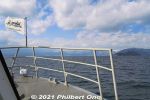
Chikubushima in sight.
|
|

"Interlaken" boat to Imazu at Chikubushima.
|
|
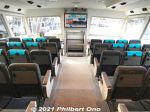
Inside the Interlaken boat. Very comfortable and looks new.
|
|
|
|

Keihan Maru boat during the early 1900s. This is a vintage postcard showing a steamer called Keihan Maru moored at Chikubushima. This boat landing is still being used.
|
|

Leaving Chikubushima.
|
|

Chikubushima's west side.
|
|

On the mountain top is Biwako Hakodateyama ski grounds near Imazu. びわこ箱館山
|
|
|

Approaching Imazu in winter.
|
|
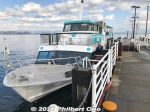
Interlaken at Imazu Port.
|
|
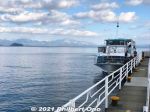
Imazu Port with Chikubushima and Mt. Ibuki in the background.
|
|
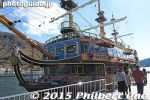
Our boat named "Victory."
|
|
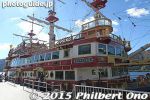
The other pirate boat's name was "Royale."
|
|
|
|
|
|
|
|
|
|
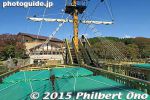
Top deck
|
|
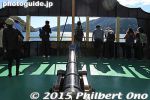
Back of our boat.
|
|
|
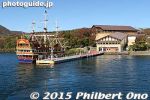
Leaving port
|
|
|
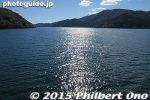
Heading for Hakone-machi on Lake Ashi in Hakone.
|
|
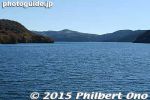
Lake Ashi (Ashinoko)
|
|
|
|
|
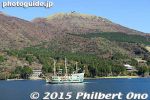
Looks like there are three pirate boats on Lake Ashi.
|
|
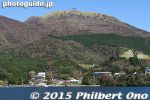
Mt. Komagatake
|
|
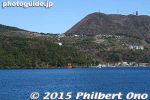
Hakone Shrine's torii
|
|
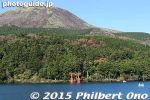
The famous torii of Hakone Shrine.
|
|

The famous torii of Hakone Shrine.
|
|

Lake Ashi's famous torii of Hakone Shrine with Mt. Fuji in the background.
|
|

Mt. Fuji and Lake Ashi
|
|
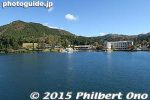
Hakone-machi Port
|
|
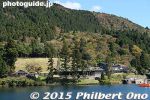
Hakone Sekisho Checkpoint
|
|
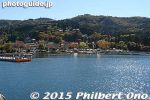
From Togendai, you have the option of going to Hakone-machi or Moto-Hakone. I wanted to go to Hakone-machi first to see the Sekisho Checkpoint.
|
|
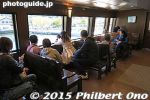
Inside our pirate boat.
|
|
|
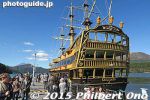
Our boat at Hakone-machi Port. The boats run quite often.
|
|

To Takeshima
|
|

Almost no one in the boat
|
|

The best way to see Kaizu-Osaki cherry blossoms is by boat. During the first half of April, cherry blossom cruises for Kaizu-Osaki depart Imazu Port a few times daily.
|
|

At Imazu Port, the boat named "megumi" goes to Kaizu-Osaki.
|
|

Imazu Port. The end of the pier has a red lamp which is also a song monument for Biwako Shuko no Uta (Lake Biwa Rowing Song).
|
|

Inside megumi with large picture windows.
|
|

Upper, open-air deck of megumi.
|
|

End deck of megumi.
|
|

Kaizu-Osaki coast ahead.
|
|

Kaizu-Osaki is famous for cherry blossoms along the lake shore. One of Japan's 100 Famous Cherry Blossom Spots.
|
|

During cherry blossom season, boats often come and go at Kaizu-Osaki Port.
|
|

Lots of cherry blossoms greet boat passengers.
|
|

megumi at Kaizu-Osaki Port, Takashima, Shiga.The cruise I went on docked at the port so we could get off and walk around for 30 min. If you go on a cherry blossom cruise, go on a cruise that will dock at Kaizu-Osaki. Some cruises only cruise and do not dock.
|
|

megumi at Kaizu-Osaki Port.
|
|

Just beware of the cars on the narrow road.
|
|

There's a footpath along the shore.
|
|

It's really beauitful to see the cherry blossoms from the boat.
|
|
|
|

Really enjoyed the cherry blossom cruise to Kaizu-Osaki. No hassle with car traffic. Totally worth it.
|
|

Boats also leave from Nagahama and Hikone for Kaizu-Osaki.
|
|

Kaizu-Osaki cherry blossoms as seen from sakura cruise boat.
|
|

Leaving Kaizu-Osaki.
|
|

Kaizu-Osaki Port. Boat cruises along the Kaizu-Osaki coast are offered during the cherry blossom season.
|
|

The boats come from Hikone, Nagahama, and Imazu Ports during cherry blossom season.
|
|

Kaizu-Osaki port. Cherry blossom (sakura) cruises are great because you can get to the sakura without fighting traffic.Best to take the cruise that lets you get off and walk around for 30 min. at Kaisu-Osaki Port. Better than the boats that only cruise and do not enter port.
|
|
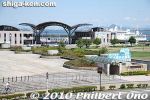
Otsu Port as seen from Hama-Otsu Station. It's a 3-min. walk from the station. MAP
|
|

Otsu Port for Michigan. These photos were taken in Aug. 2010 and earlier years. You can see how the boat's trimmings look different.
|
|
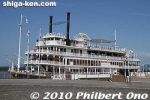
Most of Lake Biwa's cruise boats are named after Shiga Prefecture's sister states or cities. Michigan, USA is Shiga's sister state. Michigan is home to the largest lake in the US, while Shiga is home to Japan's largest lake.
|
|
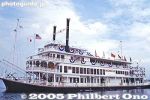
Michigan looking slightly different from years ago. Accommodates 787 passengers.
|
|
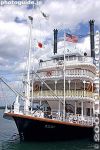
The Michigan first sailed in April 1982. It is 59 meters long and 11.7 meters wide. With 700 horsepower, it can cruise up to 8.65 knots.1982年4月2日進水。939.7総トン、全長59.0m、幅11.7m、出力700馬力、最高速力8.65ノット。
旅客定員787名。
|
|
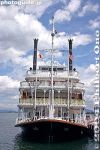
Front of the Michigan boat.
|
|
|

At Otsu Port, passengers wait to board the Michigan.
|
|

Before we could board, they had this flag signal session.
|
|
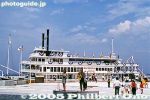
A trio of entertainers perform while passengers board the boat.
|
|
|
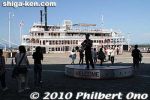
Now, only one entertainer performs as passengers board the boat in Aug. 2010.
|
|

Michigan boat at Otsu Port. I would call this boat suited for spring and fall. The open-air design can make it too hot or too cold if you don't opt to pay extra to relax in the air-conditioned rooms.
|
|
|
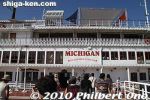
This was going to be a one-hour cruise around the Lake Biwa. This cruise which departs Otsu at 3:30 pm is called Michigan 60. Costs 2,200 yen for adults and half price for elementary schoolers.
|
|
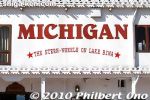
Spelling mistake...
|
|
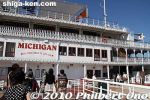
Going to board the Michigan paddlewheel boat.
|
|
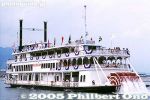
An earlier photo of the Michigan. Notice the different trimmings.
|
|

Those international flags on the top deck weren't there when I went in Aug. 2010.
|
|
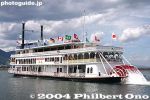
Michigan paddlewheel boat leaving Otsu Port, Shiga Prefecture, Japan.
|
|
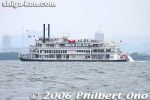
Michigan paddlewheel boat on Lake Biwa.
|
|
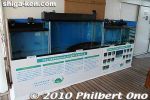
During Aug. 2010, they displayed some native Lake Biwa fish in fish tanks on the boat.
|
|
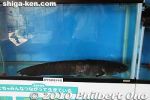
Lake Biwa catfish, a native species not found anywhere else in the world.
|
|
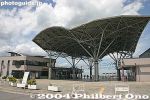
Otsu Port as seen from the boat dock.
|
|
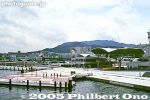
Leaving Otsu Port as the ground crew wave us off.
|
|
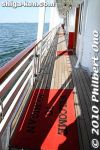
2nd floor welcome mat.
|
|
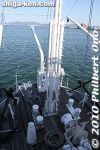
Bow of Michigan.
|
|

Bow
|
|
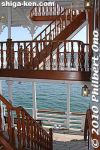
Wooden staircase on the Michigan paddlewheel boat.
|
|
|
|
|
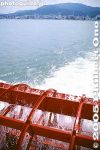
Michigan paddlewheel.
|
|
|

Open deck.
|
|
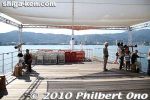
As the boat turns, the sun's striking area changes. People leave wherever the sun strikes in the heat of summer.
|
|
|
|

Featuring an entertainment stage, Becky's Square on the 3rd floor is the largest area for passengers. Unfortunately, it's not air-conditioned.
|
|
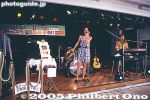
Entertainment stage on 3rd floor. The entertainers always seem to be from Australia. Instead of a trio, I think they now got only one entertainer.
|
|

3rd floor deck.
|
|

Western Otsu.
|
|
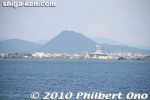
Mt. Mikami (Omi-Fuji).
|
|
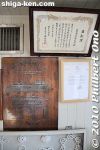
Certificates
|
|

Letter of appreciation from the governor of Michigan in 2006. Click to read the letter.
|
|

Plaque about the Michigan.
|
|

Photographers are on the prowl on the boat, offering to take your picture. After the cruise, you can buy a photo for 1,000 yen.
|
|

Matsushima Pier. There are boats which go around the Matsushima islands and return to Matsushima. Others go to Shiogama (toward Sendai) or a longer route toward Oku Matsushima.
|
|

Most boat cruises cost 1400 yen, taking about 50 min. Boats leave almost every 30 min. The boat cruise is the main and most popular activity at Matsushima.
|
|

Next to the boat pier is this building selling cruise tickets. No reservations required. You can buy a ticket even 5 min. before departure.
|
|

THe Nio Maru boat which I rode for the cruise. For an extra 600 yen, you can go on the first-class upper deck. I waited until it got sunny later in the day, then went on the cruise. The islands look better when it's sunny.
|
|

Nio Maru at Matsushima Port.
|
|

Inside Nio Maru's lower deck. Comfortable and air-conditioned. The places of interest are explained in Japanese and English during the cruise.
|
|

As each boat leaves, sea gulls follow.
|
|

The sea gulls follow where there's food, and the tourists are happy to toss junk food at them.
|
|

They even sell bird food on the boat.
|
|

These birds fly very close, within arm's reach.
|
|

Face to face with a bird. "Hey, any food for me??"
|
|

The boat passes by numerous pine-clad islands of Matsushima.
|
|

THis is one of the more famous Matsushima islands, named Kanejima with three holes. 鐘島
|
|

Kanejima
|
|
|
|

THe name "Matsushima" of course means "Pine Islands," so you may hear "Matsushima" in other places in Japan wherever there are pine-clad islands.
|
|
|

Another famous and unique island in Matsushima is Niojima, shaped like a Deva King found at the gate of Buddhist temples. 仁王島
|
|
|
|

Matsushima would also be interesting to geologists.
|
|

Famous for centuries, Matsushima has inspired many haiku poets like Matsuo Basho and painters.
|
|
|
|
|
|
|

This was my favorite island in Matsushima.
|
|

Back to Matsushima Port.
|
|

Matsushima Rest House is next to the pier, where you can buy cruise tickets or just rest on chairs. Tourist info counter also provided.
|
|

The Ekimae Sanbashi Pier, almost front and center along Toyako Onsen's lake shore, has cruise boats leaving for lake cruises to the Nakajima islands every 30 min. from 8 am to 4:30 pm during April-Oct.
|
|

This cruise boat, called Espoir, looks like a medieval European castle. It's a double-hulled boat. The lake cruise fare is 1,320 yen for adults and 660 yen for kids. (Slightly more expensive during Nov.-April.)
|
|

During Nov.-April, it operates every hour from 9 am to 4 pm. The cruise takes 50 min. if you don't get off to visit the Nakajima islands. Otherwise, allow 80 min. if you want to get also step foot on the Nakajima islands.
|
|

The lake cruise boat heads back to shore as the Windsor Hotel (G8 Hokkaido Toyako Summit venue) can be seen on the hill above. More boat cruise photos here.
|
|

The Windsor Hotel, G8 Hokkaido Toyako Summit venue is on a hill overlooking the lake. Below is a lake cruise boat.
|
|
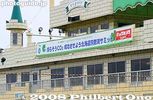
The lake cruise boat with G8 Hokkaido Toyako Summit welcome sign.
|
|

Way to Ekimae Sambashi Pier at Toyako Onsen Spa. A short walk from the bus terminal.
|
|

Ekimae Sambashi Pier at Toyako Onsen Spa. The lake cruise fare is 1,320 yen for adults and 660 yen for kids. (Slightly more expensive during Nov.-April.) 駅前桟橋
|
|

Espoir is the name of this lake cruise boat shaped like a medieval European castle. Can't get more gimmicky than that.
|
|

Another cruise boat. The cruise boats leave every 30 min. from 8 am to 4:30 pm during April-Oct. During Nov.-April, it operates every hour from 9 am to 4 pm.
|
|

Inside the Espoir lake cruise boat. This is the lower deck. The boat is obviously available for hire for private parties and cruises.
|
|

Upper deck is also very spacious.
|
|

Leaving Toyako Onsen
|
|

Toyako Onsen as seen from the lake.
|
|

Most of the passengers were Chinese tourists. I came across Chinese tourists quite often in Hokkaido. They are certainly helping to support Japan's tourist industry.
|
|

Leaving Toyako Onsen
|
|
|

Front of the boat.
|
|

Destination: Nakajima islands
|
|

There are four Nakajima islands. Each one has a name. On the far right is the smallest island, named Manjujima island. Also nicknamed Snake Island since they say it has many vipers. 饅頭島
|
|

The island on the left is Kannonjima island which is connected to Bentenjima island on the right via a sandbar. The islands are not accessible during winter.
|
|

Kannon island, so called because there is a Kannon temple. 観音島
|
|

Ezo deer on Benten island.
|
|

Benten temple on Benten island
|
|

Kannon temple on Kannon island.
|
|
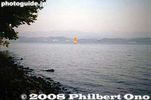
Ukimido as seen from Benten island
|
|

Transparent water
|
|

Heading to Oshima island.
|
|

Oshima is the largest Nakajima island.
|
|
|

Oshima island, Nakajima islands.
|
|

Boat dock at Oshima island. This island has a small nature museum.
|
|

Leaving Oshima.
|
|

Sea gull on the lake.
|
|
|
|